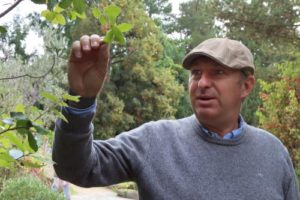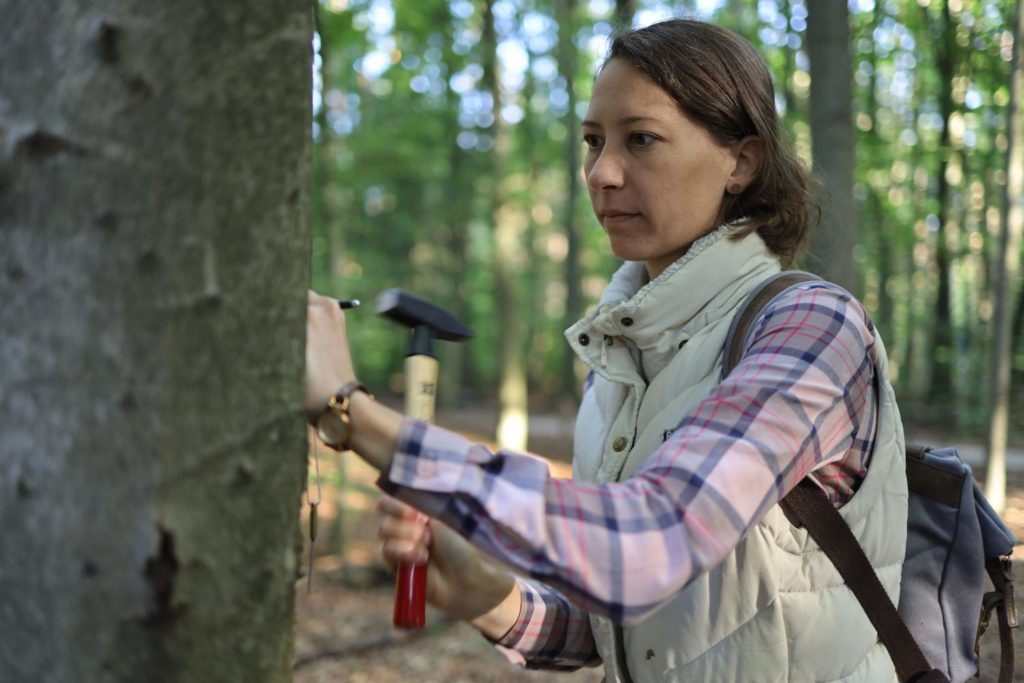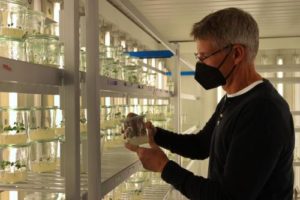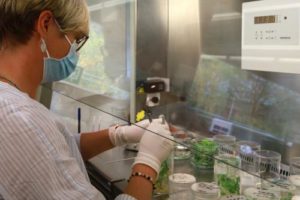Trimmed to fit
Can the flora still be adapted to climate change?
The second decade of the 21st century was the warmest in Germany since systematic records began back in 1881. At 10.4 °C, the average temperature in 2020 was 2.2 degrees above the reference period from 1961 to 1990. These figures from Germany’s National Meteorological Service confirm the findings of the Intergovernmental Panel on Climate Change (IPCC): human-induced global warming, predicted by scientists for decades, is progressing at an accelerating pace.
Plants are under stress
What can we do here in our part of the world? Calling for a radical restructuring of our affluent society patently ignores the fact that people often put their own interests first: “Tunica propior pallio est” – the tunic sits closer than the cloak, as Roman poet Plautus once said. Catastrophic photographs of extreme flooding in Germany – to name just one example – will not halt the proliferation of petrol-guzzling campervans.
Let’s be realistic. We are confronting the climate crisis with a mindset that is more interested in saving our own skins. Our actions are anthropocentric, for the benefit of our own country, our own community and ourselves. Although the entire ecosystem of our native flora is threatened, we will presumably concentrate first on the useful plants found in our gardens or in the forests or fields.

Claus Heuvemann, Scientific Director of the Botanical Garden in Erlangen, is responsible for monitoring about 5,000 trees on FAU’s grounds. ‘Watering them won’t help against climate change,’ he says, with reference to the staffing and technical resources at his disposal. But even if we managed to give the trees in our towns and cities, which are often planted on sealed areas, sufficient water, we would still not gain much, he says.
‘They don’t die from heat and drought alone, but from continuous environmental stress as well as fungal and insect infestation as a result.’ Often, environmental and other stress factors have not even been sufficiently researched. This applies not only to tree species planted in places that are less than ideal but also even to the copper beech (Fagus sylvatica), which has been adapted to Central Europe’s climate for thousands of years. Global warming is quite simply changing too much too quickly.
Over the last 25 years, symptoms of disease have been observed on a mounting scale above all in mature copper beeches, although they should in fact have a good supply of nutrients due to their age. Starting from the crown, large sections of bark die off, which frequently leads to heart rot and ultimately to the tree dying. The disease is known as beech bark necrosis or beech complex disease, in which several environmental factors play a part either simultaneously or consecutively. Visible fungal infestation with beech tarcrust (Biscogniauxia nummularia) or insect infestation with the woolly beech scale (Cryptococcus fagisuga) evidently plays only a subordinate role.
In the case of sooty bark disease, which attacks maples, the culprit is easier to identify. This infectious fungal disease is caused by the spores of Cryptostroma corticale. However, the following applies in this case too: ‘The fungus is already present in the healthy tree, but it only triggers the disease when the tree is under stress,’ explains Heuvemann.
The weakened maple is confronted with a fungus whose optimum growth temperature is 25 °C. With each hot summer, symptoms worsen. The bark forms blisters and detaches from the trunk, revealing millions of sooty black spores that are dispersed by the wind. If inhaled, the spores, just a few micrometres in size, can also enter the human lung and, in extreme cases, cause inflammation. That is why this fungal infestation is also known as woodman’s disease.
Which trees should we plant in future?

Phenological observations by Germany’s National Meteorological Service between 1961 and 2010 corroborate that spring in Bavaria is starting ever earlier. Some plants start sprouting up to three weeks sooner than usual. This naturally also has an impact on many animal species. The caterpillars of some butterfly species, for example, are dependent on leaves that have only just unfolded. If the caterpillars hatch weeks later, they are pushed to find food. As a result, there are fewer butterflies to pollinate plants, and the caterpillars themselves are easy prey for birds and bats.
Because ecological interdependencies are highly complex, it is difficult for gardeners and foresters to develop adaptation strategies that go beyond the instinctive reaction to plant heat-tolerant species. ‘In fact, we ought first of all to test the effects over decades,’ says Heuvemann. He says that Hungarian oak (Quercus frainetto), downy oak (Quercus pubescens) or the wild service tree (Sorbus torminalis) would be suitable choices for urban environments.
The common hornbeam (Carpinus betulus) also loves warm weather and would make a good street tree, but it is sensitive to direct sunlight, says Heuvemann. The red oak (Quercus rubra) would be an alternative to the (dying) pine trees on the university’s South Campus, but certainly not as a monoculture. ‘The disadvantage is that its sticky foliage literally suffocates the forest floor and prevents a rich mix of different species from growing.’
‘We must in any case focus on variety,’ he says. As temperatures rise, so too do staffing and financial costs for new plantings. ‘Nursery capacities are already barely sufficient as it is. A seedling requires ten years of intense care until it can be planted.’
The future of woodland as an economic factor
Similar adaptation problems are also looming for the forestry sector. ‘How can we preserve woodland as an economic factor?’ asks Annette Debel, geographer and a doctoral student of Professor Achim Bräuning, Chair of Physical Geography at FAU. In the framework of BayTreeNet, an interdisciplinary collaborative project, she is examining the local impacts of macro weather patterns on the growth of tree species important for forestry. Other sub-projects are concerned with climate modelling and educational work in the area of sustainable development.
At the Tennenlohe Forest Experience Centre stands one of eleven “Talking Trees”, whose trunk diameter and sap flow are measured in real time and posted online. School students compare the results with the weather at the respective time and translate their talking tree’s messages into everyday language, thus sensitising their peers to the consequences of global warming. ‘In this way, children and young people can experience at first hand how climate change affects a Scots pine that is, as it were, right on their doorstep,’ says Debel.
The data are not always easy to interpret: when the temperature rises, more water evaporates at the stomata of the leaves, which leads to negative pressure in the sapwood’s vascular bundles. This in turn slightly reduces trunk diameter and increases the transport of water and nutrient salts in the direction of the crown. The tree needs the water for photosynthesis, which supplies energy and building materials for creating new wood cells.
The new wood cells develop in the cambium, the growth zone between the bark and the sapwood. In the spring, thin-walled cells form that facilitate water transport, in the autumn, thick-walled ones that give the wood its stability. Using Trephor, a tool specially designed for the purpose, Annette Debel extracts cores, two to three centimetres long and 1.5 millimetres thick, from the growth zone of test trees situated near the Forest Experience Centre. In this way, she is better able to differentiate growth processes within a tree ring in terms of time.
The end for spruce and pine?
Annette Debel has taken samples from five copper beech (Fagus sylvatica) and five Scots pine (Pinus sylvestris) every two weeks from April to the end of October since 2020. Staff from the Bavarian State Institute of Forestry (LWF) and other helpers take samples at ten other sites in lowland and highland regions across Bavaria. In the higher elevations, Norway spruce (Picea abies) was selected in place of pine.
The microcores from all eleven sites are collected at FAU’s Department of Geography. By embedding them in paraffin, thin sections can be sliced. Annette Debel then analyses three phases under an optical microscope: cell enlargement, lignification and mature cells. As the weather data of all eleven sites are known, correlations can be made between time and wood growth.
‘A large part of the wood cells is produced within two to three months, whereby especially the early wood correlates with weather conditions,’ says Debel, presenting preliminary results of her research work. She says that the deciding factor is not only the average temperature but also above all water supply during the main growth phase in June and July. ‘Spruce will no longer survive in lowland regions, and even beech will face problems.’ Microcore analysis is a suitable method for understanding the local impact of climate change in Bavaria, she says. ‘We’re examining the actual state so that we can forecast how certain macro weather patterns impact on wood growth in various parts of Bavaria.’ She admits, however, that understanding the entire woodland ecosystem requires a lot more research.
Is genetic engineering the solution?

Whereas ecosystem research is still in its infancy, green genetic engineering is already providing solutions for adapting crops to climate change. But in Germany the cultivation of transgenic plants is prohibited.
Although we protect ourselves with highly effective mRNA vaccines (red genetic engineering) and disregard the fact that genetically modified microorganisms (white genetic engineering) produce enzymes for the food and detergent industries as well as hormones such as insulin, when it comes to our food, we want it produced without genetic engineering. Why?
Humans have been modifying plants for at least 10,000 years through more and more efficient breeding methods (see box). Radioactive beams were fired at the genome of malting barley for so long until a mutation occurred by chance that made the plant resistant to powdery mildew, a fungal disease. Genetic engineering produces mutations as well, but very much faster and in a more targeted way.
‘When I modify something, I must prove that I’m not harming humans or the environment, irrespective of the method I’m using,’ says Professor Uwe Sonnewald, Chair of Biochemistry at FAU, who has been studying plant breeding for decades. What’s important, he says, is the end product. ‘There is not a single case anywhere in the world where a genetically modified plant has managed to dominate in the wild.’
To meet global food demand in 2050, maize, rice, wheat and soybean yields would have to increase by 2.4 per cent each year, says Sonnewald. But that’s still a long way off. ‘We have to increase food production, either through more fertiliser, more chemicals, more land use – or else through genetic engineering.’ Not least because climate change could lead to a massive decline in crop yields in many places.
Let’s take the potato as an example. It reproduces sexually via seeds and asexually via tubers. In its natural environment, the Andean highlands, the potato reaps the information it needs for flower formation by measuring the length of the day and the temperature. ‘Long days and high temperatures encourage flowering in the summer, whereas short days and falling temperatures promote tuber formation in the autumn,’ explains Sonnewald. The potato varieties cultivated in Europe have lost this dependency on the length of the day and adapted to the climate that has so far prevailed here: they flower in the summer and start to form tubers shortly afterwards. Until now, the ambient temperature in Europe has hardly influenced tuber formation at all. However, if it now rises here in Germany above 28 °C for a longer period, the plant invests in sexual reproduction and suppresses tuber formation, leading to a smaller harvest.
Heat-resistant potatoes

The protein SP6A is responsible for tuber production. If the plant registers persistently high temperatures, it produces an RNA that prevents SP6A from forming. This mechanism is the starting point for Uwe Sonnewald’s research group. ‘We’ve inserted a ‘catcher molecule’ into the plants that intercepts the small regulatory RNA and in so doing protects SP6A against degradation.’ Prototypes of this heat-resistant potato are already growing in the department’s greenhouse – as a man-made answer to man-made climate change.
Field trials in the USA will follow in 2022. ‘If the legal situation in Europe changes, these heat-resistant potatoes could – after rigorous controls – come onto the European market in around 2030,’ says Sonnewald. ‘Our job is to conduct basic research and offer society options, which it can then make use of – or not, as the case may be.’
Because rapidly advancing climate change means that many crops are obliged to adapt, the speed of conventional breeding methods will presumably no longer suffice. Green genetic engineering could provide a remedy. ‘Demonising green genetic engineering for ideological reasons is ethically indefensible and extremely risky for the food supply of future generations,’ says Sonnewald.
From wild plant to crop
To meet their needs, humans have been breeding plants for at least 10,000 years. However, the genome of crop plants only changed very slowly because selection took place without knowing the genetic mechanisms. This only changed when Augustinian monk Gregor Johann Mendel (1822–1884) discovered the principles of inheritance. These were recognised by science in 1900 and used for crossbreeding.
Since then, breeding methods have invariably developed in parallel with scientific progress. Plant breeding increasingly became a matter for specialists, explains Sonnewald. Further stages were hybrid breeding (in the 1920s), mutation breeding (1930) and breeding by means of cell fusion (1960). Sonnewald stresses that none of these genome modifications were deliberate. Genetic fixation of the selection was still left to chance, the desired success only came about after extensive backcrossing and many plant generations.
With green genetic engineering, which came into use in the early 1990s, it was possible to modify the genome for the first time. Further milestones were marker-assisted breeding (2000) and genomic selection (2010). In the shape of genome editing (2012), which allows the rapid and targeted introduction of mutations, plant breeders now have a tool at their disposal that allows them to produce new plant varieties in a comparatively short space of time.
Genetic engineering is still a highly contentious topic. We should, however, bear in mind that crops plants produced by means of conventional breeding developed anything but naturally. The ancestral form of cultivated maize is teosinte, a species of grass. In the course of over 9,000 years of domestication, it acquired a sturdy stalk, its airy ears became hardy cobs with grains arranged in several rows that stick firmly to them. Wild and cultivated forms are very different. The oldest cobs for which there is archaeological evidence were no more than two centimetres long. Today they can exceed 20 centimetres.
About the author
Mathias Orgeldinger holds a PhD in biology and is a freelance journalist. He writes and photographs for various newspapers and magazines.
FAU research magazine friedrich

This article first appeared in our research magazine friedrich. You can order the print issue (only available in German) free of charge at presse@fau.de.
All articles
